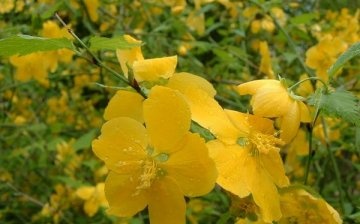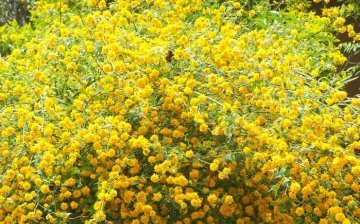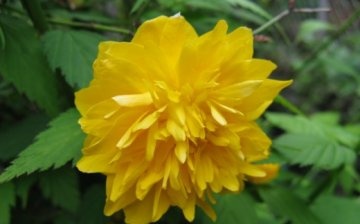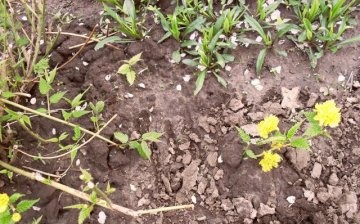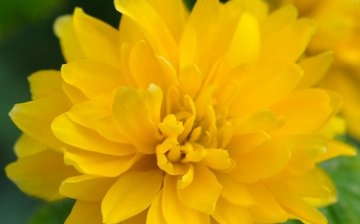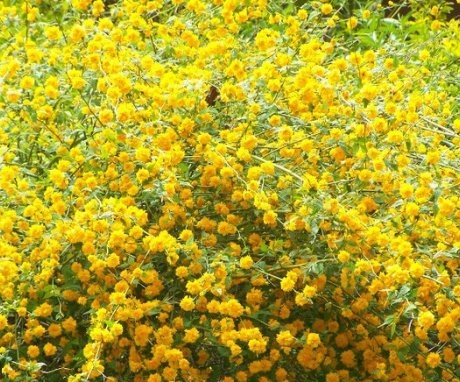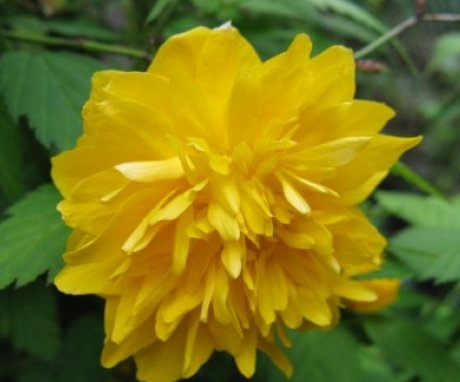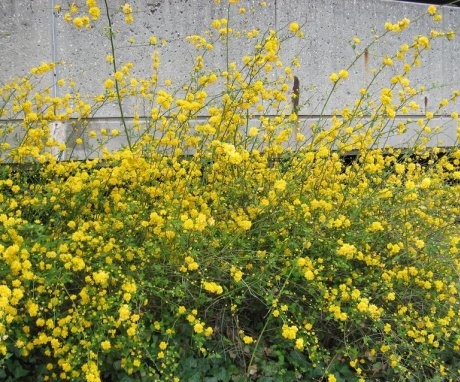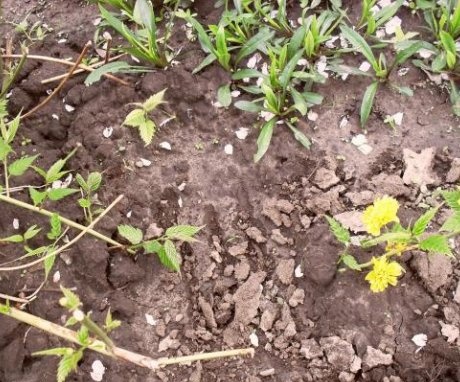Japanese keria: care, reproduction and use in landscape design
Japanese keria belongs to the Rosaceae family. Its homeland is Japan and China, the places of growth are mountains and forests.
Content:
- General information about the Japanese keria
- Japanese keria varieties
- Care for Japanese keria
- Reproduction of Japanese keria
- Application in landscape design
General information about the Japanese keria
Keriya is a shrub that can be up to 2 meters high.
Shoots are smooth, green, do not branch. The shrub grows quickly enough under favorable conditions. The root system develops rapidly and produces many new shoots. Due to this, the bush is very bgrows rapidly and has a dense density.
The leaves of this plant are very beautiful and, like flowers, represent the decorative value of the bush. The shape of the leaves is elongated and toothed, in the lower part they are slightly pubescent. In spring and summer, the leaves are light green, and by autumn they acquire a bright yellow color.
The advantages of Japanese keria over other shrubs are that in the spring it blooms first, and the flowering period can last from 25 to 50 days.
The flowers are bright yellow in color and are located on the branches one by one. The flower can be up to 6 cm in diameter. After the bush has bloomed profusely for the first time, new flowers will appear throughout the entire period, but not as densely as in spring. It tolerates frosty winters well, and even if the bush freezes a little, it quickly recovers after pruning in the spring.
Japanese keria varieties
Keria Japanese Pleniflora:
- This bush stands out among others for its beautiful flowers, like small roses.
- Its branches can reach 2 meters in height, and in width the bush grows by 1.5 meters.
- Shoots resemble twigs in appearance, have a greenish color.
- The leaves are elongated, green in spring and summer and yellow in autumn.
- For the winter, the bush sheds all the foliage.
- Flowers of bright yellow color grow up to 5 cm in diameter.
- Flowering begins in May and lasts until early summer.
- Re-flowering may occur in autumn.
- Propagated by cuttings and new basal shoots.
Keria Japanese Variegata:
- This shrub is less tall than other varieties, the height of the branches reaches only 60 cm.
- It grows up to 1.2 meters wide.
- The oblong leaves are green and covered with light, milky spots.
- The flowers are small, five-petalled, yellow in color.
- Growth rate is high.
- Propagated by cuttings and new basal shoots.
Keria Japanese Albomarginata:
- The bush reaches a height of up to 2 meters and a width of up to 1.5 meters.
- It blooms with beautiful yellow flowers with five petals.
- It differs from other varieties in variegated leaves.
- Painted green, they have a light border around the edges, which attracts gardeners and designers.
- It grows quite moderately, and the leaves and flowers are not as dense on the branches as in other varieties of this plant species.
- Propagated by cuttings and root shoots.
Keria Japanese Albiflora:
- This shrub has small white flowers that are densely located on the branches.
- Bushes up to 2 meters high grow up to 1.5 meters wide.
- The leaves are dark green, oblong, turn yellow by autumn and subsequently fall off.
- This variety combines well with yellow-flowered varieties of Japanese keria.
- Propagated by cuttings and root shoots.
Care for Japanese keria
Keria Japanese is an unpretentious plant that tolerates winter well. It is planted mainly in sunny and well-lightened places, but it takes root well in partial shade.
The main condition for good growth and flowering: This is a well-moisturized soil and regular feeding of the plant. But it is not worth pouring Japanese keria, watering is done as needed. It is necessary to feed the plant immediately after the main spring pruning.
Fertilizer can be compost and ash, which should be sprinkled around the plant in a small layer.
Pruning plays an important role in caring for such shrubs:
- After winter, it is necessary to remove weak and damaged branches and shoots.
- And cut out those branches that create an increased density of the bush, that is, to clear a place for new, young shoots.
- The main pruning and formation of the bush takes place after the first, abundant flowering.
- With this pruning, the fourth part of the shoot is cut off, on which the flowers were located.
- Forking or a good, strong bud can serve as a landmark.
- Young shoots are also shortened.
- And after a few days, lateral branches begin to grow from these shoots.
- This gives additional density to the crown of the bush.
If the bush is old enough, more than 5 years old, then it is necessary to carry out spring rejuvenation. To do this, cut out several old branches, 5-7 pieces. Thus, space is freed up for new young shoots, and the remaining branches are strengthened.
Reproduction of Japanese keria
The Japanese Keriya tolerates a transplant very well at any time. But it is advisable to carry out such an operation in spring or autumn.
To breed keria, it is not necessary to dig out a whole bush:
- It is enough to dig deep side shoots and transplant them to a permanent place.
- For new bushes, it is better to choose a place in partial shade, with the expectation that the bush will grow rapidly.
- Pits 50 by 50 cm are dug in the required area and filled with good, seasoned compost a little.
- A bush is put on top and buried to the previous level.
- After the pit is well watered and mulched.
Keria also propagates well by cuttings.
In early summer from strong shoots cut the cuttings up to 6 cm long. And on each such cuttings there should be at least 2 buds. For such cuttings, greenhouses are prepared, where they are planted in prepared soil. By the fall, most cuttings have already grown good roots and are transplanted into open ground. Next year it will be ready-made seedlings for landscaping the site.
Application in landscape design
Due to its early flowering and unpretentious care, Japanese keria is very often used for single landings in gardens and parks. Also, these bushes are often used for planting in front of bushes, with their bright flowering they create a beautiful contrast. Japanese keria looks great in partial shade when the bushes are planted in shady parks.
In landscape design near private houses, it is recommended to plant keria near high stone walls, this creates a beautiful background for the bushes.
Also, as a background, you can use evergreen conifers, or tall bushes with red foliage. Japanese keria is very often used designers for planting in shady places where many other similar plants do not take root. It is also combined with spring bulbous flowers and ground cover plants.
More information can be found in the video.



